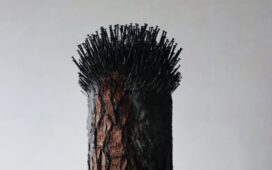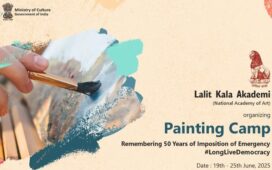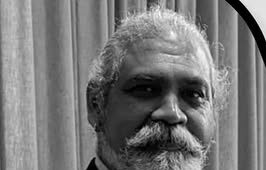“Is ‘unsatisfaction’ a gift given to art?
Many artists responded to this question, but those who make a living through art had different opinions. They didn’t understand the concept of changing styles or being unsatisfied. Considering all this, it’s essential to know more about art.
Why do we serve art?
Everyone should ask themselves this question. Why and for what purpose? If we answer these questions honestly, we can connect with art. We try to express our inner feelings and thoughts through art. It’s crucial to have an innate liking for it and to be deeply engaged in it. If art is used for commercial purposes, then it’s unlikely that they will understand the significance of these questions, and it’s better for them to ignore such questions. Anyway, everyday life, nature around us, and our mental state are constantly changing, and this should be reflected in art, whether it’s a sense of joy or satisfaction.

The expectation from an artist is that they should express their true feelings, whether it’s happiness, sadness, or anything else. If someone creates art based on others’ demands, it’s not wrong; it can lead to exploring different types of work and bringing stability to life. However, if someone only focuses on commercial work and doesn’t have time for personal expression, then I call them a craftsman, not an artist.
Dr. Mohan Des’s response resonated with me, so I’m sharing it here: “A mold is a tool for creating fixed art, not a medium. A mold itself can be art, but only once. Forcing a creation into a mold is a violation of art. However, when an artist realizes that their work is no different from mass-produced corporate products, it’s often too late. At that point, the artist has become a mold themselves, losing their identity.”
Two different style of paintings. Artist Sharad Tarde.
–Mohan Des . (FB)

“ಕಲೆಗೆ ‘ಅತೃಪ್ತಿ’ ಒಂದು ಕೊಡುಗೆಯೇ? ಈ ಪ್ರಶ್ನೆಗೆ ಅನೇಕ ಕಲಾವಿದರು ಪ್ರತಿಕ್ರಿಯಿಸಿದರು, ಆದರೆ ಕಲೆಯ ಮೂಲಕ ಜೀವನ ಮಾಡುವವರು ವಿಭಿನ್ನ ಅಭಿಪ್ರಾಯಗಳನ್ನು ಹೊಂದಿದ್ದರು, ಅವರು ಶೈಲಿಗಳನ್ನು ಬದಲಾಯಿಸುವ ಅಥವಾ ಅತೃಪ್ತರಾಗುವ ಪರಿಕಲ್ಪನೆಯನ್ನು ಅರ್ಥಮಾಡಿಕೊಳ್ಳಲಿಲ್ಲ. ಇದೆಲ್ಲವನ್ನೂ ಪರಿಗಣಿಸಿ, ಇದು ಅತ್ಯಗತ್ಯ. ಕಲೆಯ ಬಗ್ಗೆ ಇನ್ನಷ್ಟು ತಿಳಿದುಕೊಳ್ಳಲು ನಾವು ಈ ಪ್ರಶ್ನೆಯನ್ನು ಏಕೆ ಮತ್ತು ಯಾವ ಉದ್ದೇಶಕ್ಕಾಗಿ ಕೇಳಬೇಕು? ಅದರ ಬಗ್ಗೆ ಸಹಜವಾದ ಒಲವನ್ನು ಹೊಂದಿರುವುದು ಮತ್ತು ಅದರಲ್ಲಿ ಆಳವಾಗಿ ತೊಡಗಿಸಿಕೊಳ್ಳುವುದು ಬಹಳ ಮುಖ್ಯ. ಕಲೆಯನ್ನು ವಾಣಿಜ್ಯ ಉದ್ದೇಶಗಳಿಗಾಗಿ ಬಳಸಿದರೆ, ಅವರು ಈ ಪ್ರಶ್ನೆಗಳ ಮಹತ್ವವನ್ನು ಅರ್ಥಮಾಡಿಕೊಳ್ಳುವ ಸಾಧ್ಯತೆಯಿಲ್ಲ ಮತ್ತು ಅಂತಹ ಪ್ರಶ್ನೆಗಳನ್ನು ನಿರ್ಲಕ್ಷಿಸುವುದು ಅವರಿಗೆ ಉತ್ತಮವಾಗಿದೆ.

ದೈನಂದಿನ ಜೀವನ, ನಮ್ಮ ಸುತ್ತಲಿನ ಪ್ರಕೃತಿ, ಮತ್ತು ನಮ್ಮ ಮಾನಸಿಕ ಸ್ಥಿತಿ ನಿರಂತರವಾಗಿ ಬದಲಾಗುತ್ತಿದೆ ಮತ್ತು ಇದು ಕಲೆಯಲ್ಲಿ ಪ್ರತಿಫಲಿಸಬೇಕು, ಅದು ಸಂತೋಷ ಅಥವಾ ತೃಪ್ತಿಯ ಭಾವವೇ ಆಗಿರಬಹುದು. ಕಲಾವಿದರಿಂದ ನಿರೀಕ್ಷೆಯು ಅವರು ತಮ್ಮ ನಿಜವಾದ ಭಾವನೆಗಳನ್ನು ವ್ಯಕ್ತಪಡಿಸಬೇಕು, ಅದು ಸಂತೋಷವಾಗಿರಬಹುದು, ದುಃಖ, ಅಥವಾ ಇನ್ನೇನಾದರೂ. ಯಾರಾದರೂ ಇತರರ ಬೇಡಿಕೆಗಳ ಆಧಾರದ ಮೇಲೆ ಕಲೆಯನ್ನು ರಚಿಸಿದರೆ, ಅದು ತಪ್ಪಲ್ಲ; ಇದು ವಿವಿಧ ರೀತಿಯ ಕೆಲಸಗಳನ್ನು ಅನ್ವೇಷಿಸಲು ಮತ್ತು ಜೀವನಕ್ಕೆ ಸ್ಥಿರತೆಯನ್ನು ತರಲು ಕಾರಣವಾಗಬಹುದು. ಆದರೆ, ಯಾರಾದರೂ ಕೇವಲ ವಾಣಿಜ್ಯ ಕೆಲಸಗಳತ್ತ ಗಮನಹರಿಸಿದರೆ ಮತ್ತು ವೈಯಕ್ತಿಕ ಅಭಿವ್ಯಕ್ತಿಗೆ ಸಮಯವಿಲ್ಲದಿದ್ದರೆ, ನಾನು ಅವರನ್ನು ಕುಶಲಕರ್ಮಿ ಎಂದು ಕರೆಯುತ್ತೇನೆ, ಕಲಾವಿದರಲ್ಲ. ಮೋಹನ್ ದೇಸ್ ಅವರ ಪ್ರತಿಕ್ರಿಯೆಯು ನನ್ನೊಂದಿಗೆ ಪ್ರತಿಧ್ವನಿಸಿತು, ಆದ್ದರಿಂದ ನಾನು ಅದನ್ನು ಇಲ್ಲಿ ಹಂಚಿಕೊಳ್ಳುತ್ತಿದ್ದೇನೆ: “ಅಚ್ಚು ಸ್ಥಿರವಾದ ಕಲೆಯನ್ನು ರಚಿಸುವ ಸಾಧನವಾಗಿದೆ, ಮಾಧ್ಯಮವಲ್ಲ. ಅಚ್ಚು ಸ್ವತಃ ಕಲೆಯಾಗಬಹುದು, ಆದರೆ ಒಮ್ಮೆ ಮಾತ್ರ. ಸೃಷ್ಟಿಯನ್ನು ಅಚ್ಚಿನೊಳಗೆ ಒತ್ತಾಯಿಸುವುದು ಉಲ್ಲಂಘನೆಯಾಗಿದೆ. ಆದಾಗ್ಯೂ, ಕಲಾವಿದರು ತಮ್ಮ ಕೆಲಸವು ಸಾಮೂಹಿಕ-ಉತ್ಪಾದಿತ ಕಾರ್ಪೊರೇಟ್ ಉತ್ಪನ್ನಗಳಿಗಿಂತ ಭಿನ್ನವಾಗಿಲ್ಲ ಎಂದು ಅರಿತುಕೊಂಡಾಗ, ಆ ಸಮಯದಲ್ಲಿ ಕಲಾವಿದರು ತಮ್ಮ ಗುರುತನ್ನು ಕಳೆದುಕೊಳ್ಳುತ್ತಾರೆ.” ಎರಡು ವಿಭಿನ್ನ ಶೈಲಿಯ ವರ್ಣಚಿತ್ರಗಳು. ಕಲಾವಿದ ಶರದ್ ತಾರ್ಡೆ.
–ಮೋಹನ್ ದೇಸ್. (FB)



























